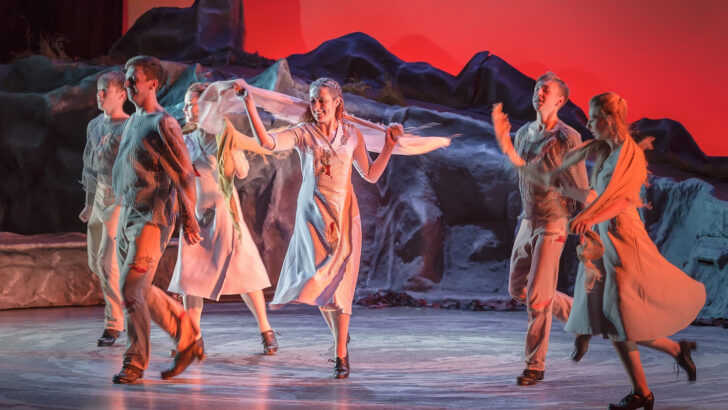Forging the Dance: Eachtraí mo Shaoil – Exploring the Concept of Folk Theatre and the Birth of Siamsa Tíre, by Pat Ahern (O’Riain Publishing, €20.00)
Mention of Siamsa Tíre brings to mind Fr Pat Ahern and vice-versa. Apart from co-founding Siamsa Tíre in 1973 Pat was its sprid, the spirit that invigorated it over the years, much to the cultural benefit of Ireland.
Pat was born in Moyvane, near Listowel, Co. Kerry, on March 5, 1932. He was educated at the local national school, St Michael’s College, Listowel, St Brendan’s College, Killarney, and St Patrick’s College, Maynooth.
Growing up in the townland of Co. Leitrim, Pat learned to play traditional fiddle. His mother was a traditional fiddle player. And as a youngster he was enthralled by the wizardry of the dance master, Jerry Molyneaux, the legendary Irish Step-Dancer of North Kerry.
Exhibited
During his studies in Maynooth Pat exhibited his love of music and skill in the various elements of that discipline, not least that of choir-master. After his ordination in1957 the bishop appointed him to a curacy in St John’s parish, Tralee. He told Pat he expected him to enhance the music-liturgy in St John’s Church and expressed a hope that he would set up a choir that would in time be the pride and joy of not only the parish but also the town of Tralee.
In this Pat did not disappoint. Apart from his choral and liturgical commitments, Pat prepared and presented hundreds of concerts featuring traditional song, dance and music, four major productions of the Apparitions at Lourdes, and a number of Passion Plays, that included the celebrated Millennium Pageant for the diocese of Kerry, ‘Dance of Life’, with a cast of 200 and a diocesan choir of 800 voices.
Pat’s life-long ministry at St John’s was interrupted on two occasions. He was seconded to the Catholic Communications Centre in Dublin from 1968 to 1973. The Centre had been set up by the Irish bishops to train priests and religious from home and abroad in the general area of communications, but especially in television.
He was given responsibility for radio. One of his tasks was to prepare the ground for the production of a religious radio programme, which would be broadcast weekly from RTÉ with the title, ‘Network’.
Later he served in the parish of Knocknagoshel on the Kerry-Limerick border from 1985 to 1990. In this small village, using a cast of local people he presented the pageant on the ‘Apparitions at Lourdes’.
This book clearly records the unique and seminal role Siamsa Tíre and Fr Pat Ahern had in that resurgence of interest”
Pari passu with his priestly ministry at St John’s, Pat was pursing his second vocation, namely, promoting Irish song, dance and music and Irish traditional folk culture by using the devices of ‘theatre’, as a way of accessing that culture.
While recruiting for his choirs, he was ever on the look-out for talented traditional musicians and dancers. With some 20 or so of those he formed a permanent group of performers and with them presented concerts and began a series of experiments in the concept of ‘folk theatre’.
In 1965 RTÉ got word of the Kerry experiments and invited the group to present a number of their programmes on the RTÉ series known as Aililiú. For this purpose the group chose the name Siamsóirí na Ríochta (The Entertainers of the Kingdom).
In time the content of those programmes became the staple element in the folk entertainment developed and fostered by Siamsa Tíre, the National Folk Theatre of Ireland, formally founded in 1974. Pat Ahern was appointed the Company’s first Artistic Director, a post he held until his retirement in 1997.
Flourish
To ensure that traditional music continued to flourish, Pat supervised the building of the Teach Siamsa in Finuge in North Kerry in 1974 and the Teach Siamsa in Carraig in West Kerry in 1975. The aim of the Teach Siamsa was to gather in and train those who were interested in traditional Irish music. This building programme was crowned in 1991 with the erection of the Teach Siamsa in Tralee, Siamsa Tíre’s home and theatre.
This book would be worth publishing if only for its wonderful collection of photographs detailing Pat’s life and achievements. I found two particularly interesting, though laced with nostalgia. There is a photo of the successful third-year class football team at Maynooth (1952- 53) – of which Pat was captain and of which I became a member on entering the college in the following year.
There is a picture of Liam Tarrant, the superb North Kerry step-dancer, performing for the ‘great and the good’ at an open-air concert at Carraig in the West Kerry Gaeltacht in 1974. As he took the applause, Liam collapsed and died instantly on stage before an audience of a thousand people!
The resurgence of interest in Irish music and dance has been remarkable in recent years. Witness the reception given to Michael Flatley’s wonderful Riverdance.
This book clearly records the unique and seminal role Siamsa Tíre and Fr Pat Ahern had in that resurgence of interest.
This book is also important for another reason. The most modest of men, Pat’s narrative tends to be all about others never about himself. Thus the contribution of the others who with Pat have given us the national treasure that is Siamsa Tíre is also fully acknowledged.


 A scene from one of Fr Pat Ahern’s productions.
A scene from one of Fr Pat Ahern’s productions. 